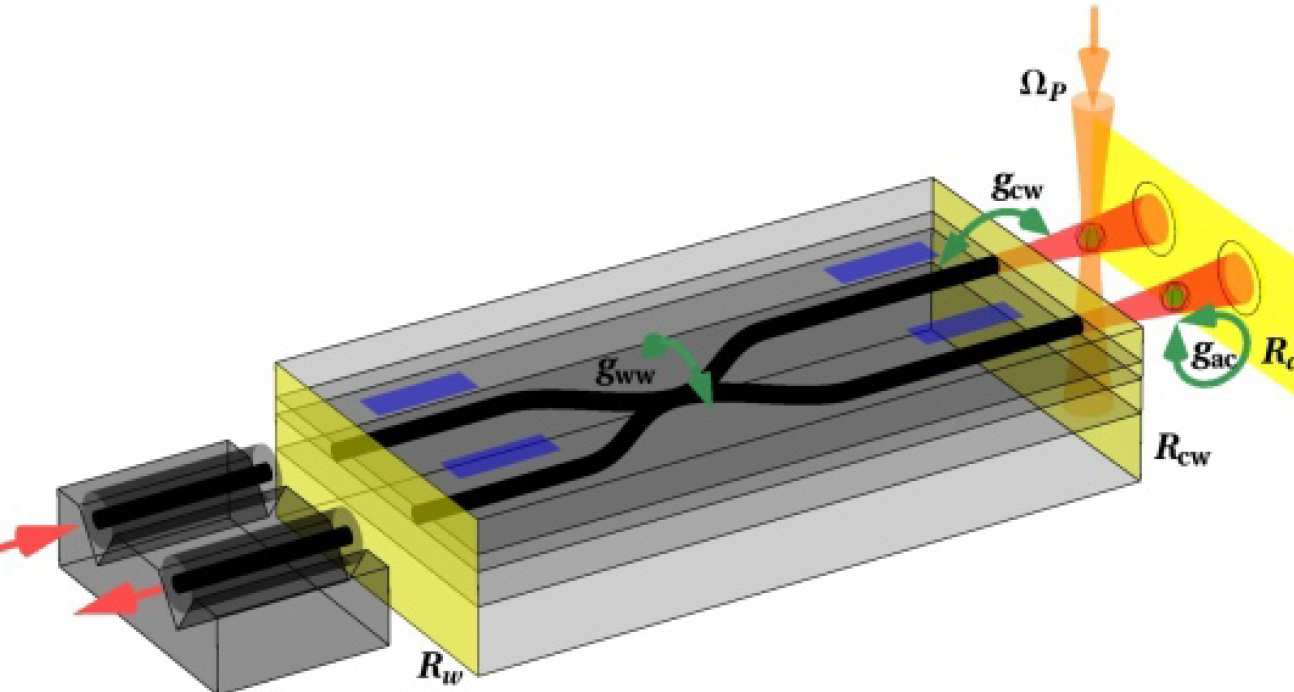See Guillaume Lepert's PhD thesis about this project: Guillaume Lepert (2013)
The field of cavity QED has witnessed spectacular progress over the last couple of decades: photon blockade, single photon non-linearities, phase gates, strong coupling have all been successfully demonstrated with cold atoms, and state-of-the art cavities showcase finesses close to 106. Further significant advances in cavity QED will be based on the interconnection of many cavities into complex networks (coupled-cavities QED, or CCQED), but this will require a major technological shift from bulky free space optical systems towards integrated photonics. Significant steps have already been taken in that direction, such as the successful operation of fibred micro-cavities [1]. Such systems typically do not reach the very high finesse of bulky cavities, but this is compensated by mode volumes smaller by an order of magnitude.
 We have developed an extension of these microcavities where the fibres have been replaced by waveguide chips [2] (see figure to the left).
We have developed an extension of these microcavities where the fibres have been replaced by waveguide chips [2] (see figure to the left).
Atoms sit in free space microcavities, facing waveguides. The latter can be routed and coupled to each other to connect a potentially very large number of micro-cavities. This design offers a degree of control unavailable to other proposed coupled-cavities system like photonic crystals, since each of the atom-microcavity couplings and each of the waveguide-waveguide couplings can be individually adjusted (using piezo or capacitive actuators and integrated thermal phase shifters, respectively).
In such a hybrid quantum system, the atoms effectively mediate photon-photon interactions by exploiting the cavity field enhancement which, by saturating the atomic transition even when only one photon is present inside the cavity, generates a non-linear phase shift. We have worked out the operating principles of the device and demonstrated successful operation of some of the basic building blocks, such as:
- optimisation of UV-written waveguide chips for operation at 780nm (Rubidium or DBT molecules)
- on-chip cross-couplers
- phase shifters
- strong coupling between a waveguide resonator and a microcavity
- Tunable coupling between two waveguide resonators [7]
The waveguide chips are fabricated at the University of Southampton by UV-writing [3], a technique that offers rapid prototyping, low cost and high flexibility and is therefore an ideal platform in a research environment. Atoms are not the only quantum system that can be placed in our array of microcavities. Quantum dots and diamonds NV centres are also suitable, and we are currently investigating cryogenic dye molecules [4]. We have also theoretically explored experiments that could be performed with the finished device. Detailed analysis of two basic scenarios with two coupled cavities are presented: spectroscopy of a Jaynes-Cummings system, and dynamics of a spin system. Our device would also be ideal for more advanced physics, including quantum phase transitions in a Bose-Hubbard model [5], high fidelity entanglement transport along a tailored spin chain [6], many-photon fast entanglement and cluster state generation, and more generally as a quantum emulator.
References
[1] M. Trupke et al, Atom Detection and Photon Production in a Scalable, Open, Optical Microcavity.
Physical Review Letters 99, 063601 (2007).
[2] G. Lepert et al, Arrays of waveguide-coupled optical cavities that interact strongly with atoms,
New Journal of Physics 13(11), 113002 (2011).
[3] G. Lepert et al, Demonstration of UV-written waveg uides, Bragg gratings and cavities at 780 nm, and an original experimental measurement of group delay, Optics Express 19, 24933 (2011).
[4] J.Hwang and E. Hinds, Dye molecules as single-photon sources and large optical nonlinearities on a chip,
New Journal of Physics 13, 085009 (2011).
[5] M. Hartmann et al, Quantum many-body phenomena in coupled cavity arrays,
Laser & Photonics Review 2, 527-556 (2008).
[6] S. Giampaolo, and F. Illuminati, Long-distance entanglement and quantum teleportation in coupled-cavity arrays, Physical Review A 80, 4-7 (2009).
[7] G. Lepert et al, Array of Fabry-Pérot waveguide resonators with tunable coupling. Applied Physics Letters 103, 111112 (2013).